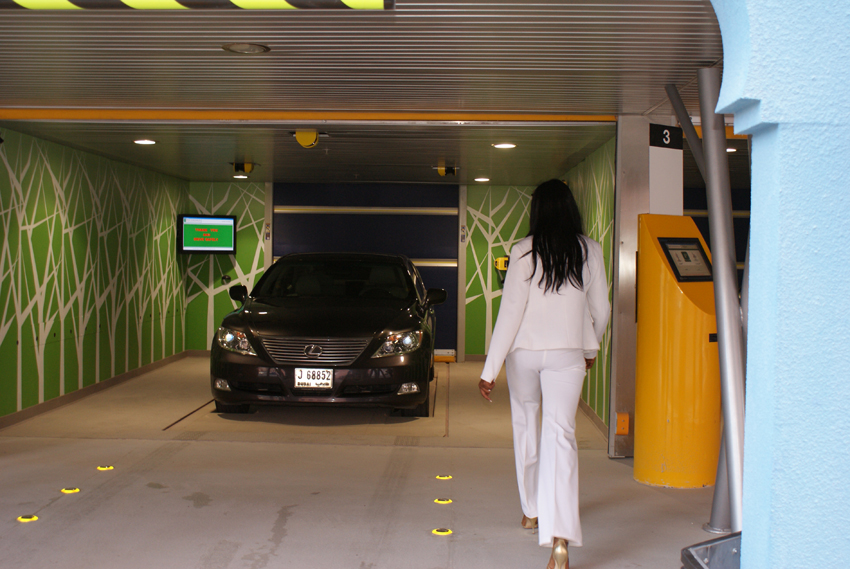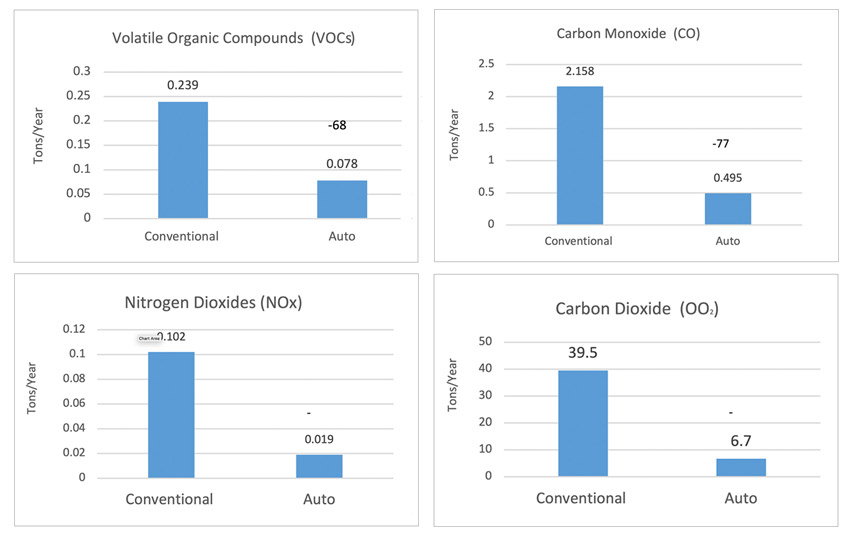The Largest Robotic Parking Systems in the World: Is the United States Ready for This?
A Healthier, Safer, and Stress-free Experience for Users
Conventional parking garages sound innocuous, but they are in fact dangerous and unhealthy. A study by the U.S. Department of Justice found that one out of 12 rapes occur in parking garages and more than 40 percent of sexual assaults by strangers occur in garages.2 Additionally, upper decks of parking garages frequently become sites for suicide.

The user experience with an automated parking system, marked with a terminal to drop off and retrieve a vehicle, is vastly different from the experience of walking through a conventional parking structure to find a parking spot or find one’s vehicle, dodging other cars, breathing fumes, and possibly encountering an assailant.
Every day, there are numerous news stories about accidents, theft, and violence in conventional parking garages and parking lots. People are hit by cars or drive off parking decks. Others are assaulted, knifed, or shot. Vehicles are vandalized and stolen.
Architects, parking designers, developers, and owners can greatly increase parking safety and security for both individuals and cars by specifying an automated parking system. The inherent safety features of the system can help significantly reduce potential lawsuits and lower insurance rates as well.
These factors make automated systems beneficial for the health and safety of users:
Less stress: While driving around searching for a parking space may seem like a necessary evil of city life, it does not have to be. Imagine giving up circling the block or the parking garage looking for a parking spot. Imagine the simplicity of driving into a terminal, locking and leaving your car, and letting the machinery and software take over. And imagine the reverse, with no stress to recalling where you parked your car. It is the equivalent of a premium valet service without the tipping.
Safety from other drivers: Dodging other cars in a parking facility is another aspect of city life that seems unavoidable. While conventional garages and lots make room for cars, virtually no consideration is made for the drivers exiting and retrieving those cars. Where do they walk safely? The automated parking system eliminates the car-versus-person dodge to which we are accustomed.
Personal safety: Most women will be familiar with a feeling of unease in conventional parking garages. With an automated system, there is no need to walk to and from the car through rows of vehicles or levels of parking decks. With an automated parking system, the driver pulls into a terminal located next to the street and leaves the car to be picked up by computerized machinery. The car is safe and protected on its own pallet, and never touched by machines or humans. When leaving, the driver returns to a lobby where the car is quickly delivered to a ground-floor terminal.
Fewer fumes: While breathing fumes from cars idling in a parking garage is yet another hazard we take for granted, an automated system completely eliminates this threat to human health. When vehicles are driven into the entry terminal of an automated system, the engine is immediately shut off and will not be started again until the driver has returned to retrieve the vehicle.
No access for thieves or vandals: Automated parking garages eliminate theft and vandalism. Vehicles are stored in a fully enclosed building and are 100 percent secure from access by others. This is a good example of a practice known as Crime Prevention Through Environmental Design (CPTED), a specialty of Randy Atlas, Ph.D., FAIA, CPP (Certified Protection Professional), who is both a criminologist and an architect. Atlas argues that buildings need to be designed for safety against crime, lest owners and operators risk liability for crimes committed.
A research brief by the U.S. Department of Justice titled “Crime Prevention Through Environmental Design in Parking Facilities” states, “Because parking facilities comprise a large volume of space with relatively low levels of activity, violent crime is more likely to occur in a parking facility than in other commercial facilities. Many parking facilities lack CPTED design features because most property owners and architects are not familiar with basic principles of design concepts for crime prevention.”3 Automated parking systems eliminate not only the fear and occurrences of crimes, but also the liability for those crimes.
No nicks or dings: Regularly parking in a conventional lot or garage almost always results in dings and dents in a car. Parking spaces are often small, and distracted people smash their door into the sides of vehicles, etc. In an automated parking system, no one touches the car after it is placed on the parking pallet. In fact, the automated parking facility itself contains only machinery and vehicles. No humans are allowed.
Touchless System in a Pandemic World
Another bonus of automated parking is the premium valet experience, which offers a contactless parking process to accommodate for pandemic needs. When the driver and the passengers have left the entry area (terminal), in higher-quality systems, the driver initiates the parking process with a touchless near-field communication (NFC) card, FOB, or mobile application. Instead of passing the keys to a valet and having a virtual stranger enter the vehicle, patrons simply use an app and keep their keys, with no other persons involved.
In simple terms, automated parking enhances the vehicle parking and retrieving experience—elevating it above the level of valet parking.
Environmental Benefits of Robotic Parking
Automated parking systems help conserve fuel while reducing pollution. No cars are driven in the garage, creating a greener garage experience. The electrical power required to run an automated parking system is low, meaning the net reduction of its carbon footprint remains significant.
EEA Consultants Inc., an environmental engineering firm, conducted a study comparing pollution and energy characteristics of a conventional 350-car garage to those of an automated garage of the same capacity.4
Data suggests that, overall, automated parking systems are better suited for the environment, reducing the amount of volatile organic compounds (VOCs) by 68 percent, carbon monoxide by 77 percent, nitrogen dioxides by 81 percent, and carbon dioxide by 83 percent. It also finds a reduction of fuel consumption by 83 percent.

Shown are the statistics on pollutant reduction for automated parking systems based on a study conducted by EEA Consultants Inc., an environmental consultancy firm.
LEED Points and Carbon Credits
An automated parking system could potentially help contribute up to 12 points or more toward LEED certification.
The areas where automated parking can help earn points include:
- Maximizing open space in site development;
- Lighting;
- Reducing chemicals and pollutants;
- Air quality;
- Energy consumption (gas saved);
- Optimizing energy performance; and
- Preferred 5 percent parking (for low-emitting and fuel-efficient vehicles) and shared vehicle storage.
Codes
As with any emerging technology, the codes change and adapt with time. Automated parking is considered an automatic storage system, unoccupied, rather than the common understanding of garages as people driving vehicles through a building structure used for parking.
International Building Code (IBC): In terms of automated parking garages, look to the Occupancy per Section 311: Group Storage S2, Section 503.1.1: Special Industrial Occupancies, and as further detailed in Section 2208: Steel Storage Racks.
Also, if the parking system is based on an open rack structure, a building is considered a one-story construction. Some jurisdictions classify automated parking systems as “equipment” and issue appropriate requirements for certain fire ratings of the surrounding supporting building elements.
International Fire Code: Chapter 23, Section 2309: Automated Storage states that: Due to the high content of plastic as well as the existence of fuel tanks in automobiles, the storage should be considered to be a “high hazard commodity,” and, in accordance with Section 2309 and Table 2306.2, require an in-rack sprinkler system per the National Fire Protection Association (NFPA) 13 as well as a building access point placed every 100 feet. These and similar requirements are also in accordance with NFPA 88A, which details such as well in its Chapter 9. Also described there are ventilation requirements of two air changes per hour, which can be satisfied, where possible, using natural ventilation.
Additional Codes
There are various codes that are available for automated parking. The following are highly common:
- National Parking Association (NPA): Guide to the Design and Operation of Automated Parking Facilities;
- American Society of Mechanical Engineers (ASME) B30.13: Storage/Retrieval (S/R) Machine and Associated Equipment; and
- All electrical equipment should be ETL or UL listed and approved.
Standard for Care
In the Standard for Care directive, a design professional has the responsibility or duty that anything that is designed needs to “fit for the intended purpose of use.” This is a very general and broad definition. However, it has become more and more important and implemented by the courts during the past 10–15 years. In the automated parking industry, it means that if an architect, engineer, or automated parking engineer knows that 400 parking spaces, for example, are needed for a residential development, he or she then has the obligation to make sure that the associated required peak traffic capacity is designed in accordance with industry standards.
According to the National Parking Association, “The most important factor for designing the access requirements for any parking facility is to determine the peak hour arrival and departure traffic volume.” This in turn determines the size and design of the automated parking structure. If a design professional does not adhere to this industry standard, he or she can be held liable by the developer or owner.
In addition, it is extremely important at the very beginning of the planning process to determine the support system grid layout of an automatic parking facility. This affects the efficiency of any facility layout and will optimize the footprint. This is exactly how planners start the layout of any building with a conventional concrete ramp parking structure. First, the column layout is determined for the parking facility. Then, the upper floors of the building are based on this column layout. This process also should be followed with an automatic parking facility.









